The 3rd International Conference of Lignocellulose
in Conjunction with
The 15th International Symposium of IWoRS
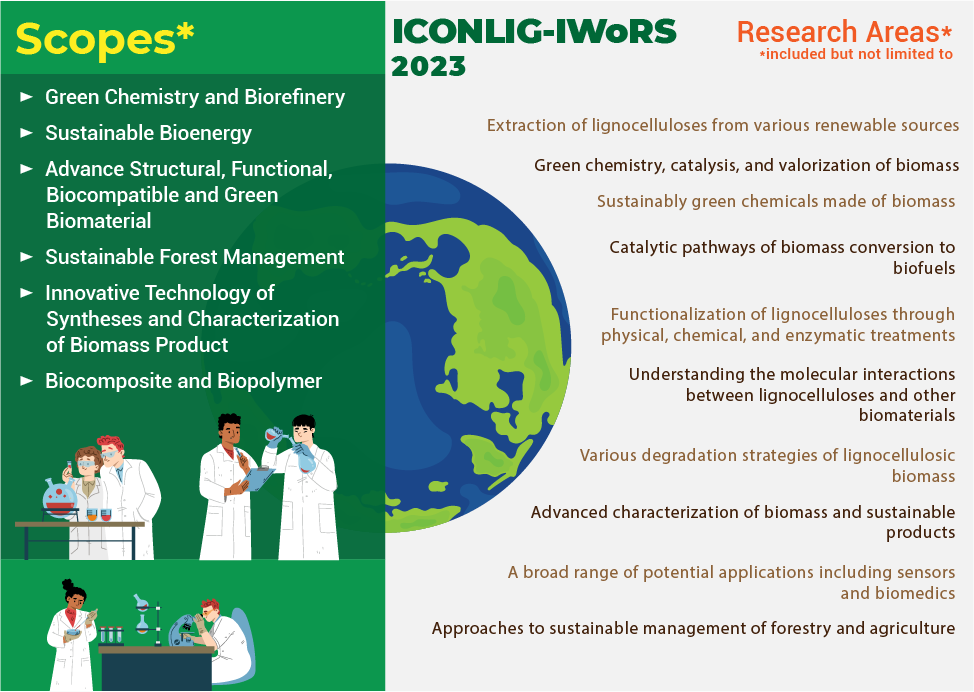
The 2030 sustainable development agenda has demonstrated climate change as one of the most adverse concerns in our present time. It threatens millions of people on this planet into the stage of poverty. Most people do not seem to have the know-how and available solutions to avert this crisis and create opportunities for a better livelihood. Climate change might have happened a few years ago. Unfortunately, we perhaps did not recognize its coming. When our world is warming faster than at any condition in the past or recorded history, we later realize its coming. It is happening today. Further, the crisis is not only attacking our global economy, but also it is hardly inducing policymakers across the globe to reshape how ideal the future would be.
The situation we are now facing is a powerful reason for real action, providing hope that our action can generate a transformative change benefiting our planet and particularly, our society.
In the middle of this chaotic environment, scientists are, thus, challenged to tackle environment-related problems through fruitful innovations. They must find critical points associated with environmental challenges, thereby reducing the impediment of sustainability efforts from remediation of global pollution to the design of green syntheses and technologies and of next-generation greener and functional materials. As an urgent action in response to this serious issue, an international platform meeting is necessary for the engineers, technologies, and scientists to share their knowledge and exchange experiences of recent updates in the scope of green syntheses, technologies, and material developments. In addition, the platform is intended to challenge the scientific communities to have a mindset of a game-changing approach, eventually helping to create more a sustainable future.
Under the global campaign ‘changing our world: the 2030 agenda for sustainable development’ echoed by the United Nations (UN), the 3rd International Conference on Lignocellulose (ICONLIG) in conjunction with the 15th National Symposium of Indonesian Wood Research Society (IWoRS) in Bogor, Indonesia, aims to broadcast recent issues related to green syntheses, technologies for the production of lignocellulosic materials worldwide. Besides that, it is also set to fuel the enthusiasm and energy of the applications of green materials for a sustainable future on our planet.TEST
Important Date
- May 2023, Registration
- 15 July 2023, Abstract Submission Deadline
- 15 July 2023, Early Bird Payment Deadline
- 20 August 2023, Full Paper Submission
- 15 September 2023, Payment Deadline
- 21-22 September 2023, Conference Days
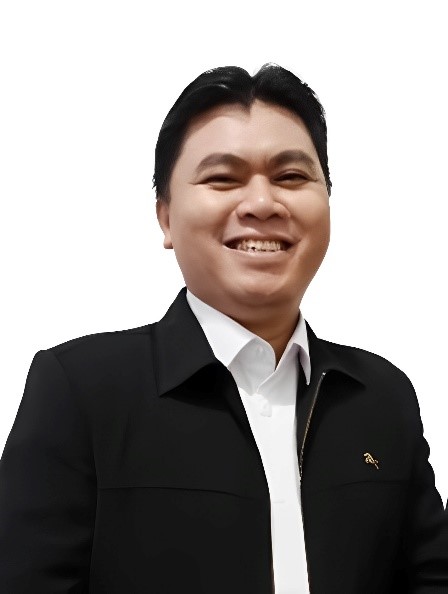
Iman Hidayat, Ph.D
Iman Hidayat, Ph.D is an Indonesian scientist and public official specialized in mycology, microbiology, and plant pathology. He completed his bachelor degree in Biology at Faculty of Mathematics and Natural Sciences, Padjadjaran University in 2002, and his doctoral degree in Plant Pathology at Faculty of Agriculture, Chiang Mai University in 2009. He was a researcher at Research Center for Biomaterial, Indonesian Institutes of Sciences (LIPI). Since 2021 he was appointed as Head of the Research Organization of Life Sciences and Environment (ORHL) at The National Research and Innovation Agency (BRIN). During his time as researcher, he completed various courses on ascomycetes taxonomy, plant pathological microorganisms, and molecular phylogenetics.
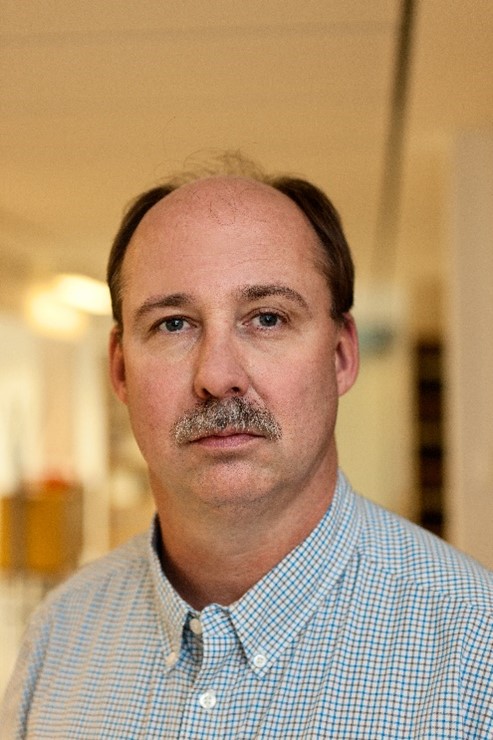
Prof. Thaddeus Maloney
(Aalto University, Finland)
Thaddeus Maloney is associate tenured professor at Aalto University where is has been employed since 2009 and is also visiting professor at Coimbra University in Portugal. He has worked in the forest products and allied industries in a range of production and research positions. His main research on lignocellulosic fibers and their applications. He has authored over 90 papers on pulp fibers, paper and composites, nanocellulose and other topics.
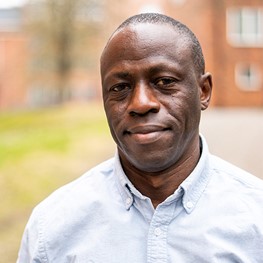
Prof. Martin Lawoko
(KTH, Sweden)
Martin Lawoko, Ph. D is a professor of Department of Fibre and Polymer Technology, KTH Royal Institute of Technology, Sweden. He previously did postdoctoral research at the University of Maine, Department of Chemical and Biological Engineering, USA. He has more than 70 publications in high-impact journals. Currently, he is supervising 4 doctoral students and 2 postdoctoral researchers. His specialties are Lignin chemistry, biorefining and valorization.
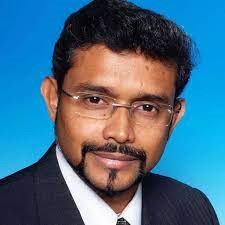
Prof. Sudesh Kumar
Prof. Sudesh Kumar (PhD, RIKEN Institute & Saitama University, Japan) is a Professor of Microbiology and Biotechnology at the School of Biological Sciences, Universiti Sains Malaysia (USM). His specialization is in the field of microbiology, genetics and polymer chemistry of microbial polyesters (bioplastics). Prof. Sudesh has published more than 90 original research articles, two books, four patents, with more than ten PhD students graduated under his supervision, and he was awarded with multiple national and international grants. He is currently a RIKEN program coordinator in USM.
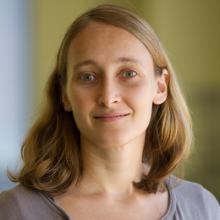
Tina Schneider
(Deputy Director, Forest Legality Initiative, World Research Institute DC, USA)
Tina is the Director for Forest Governance and Policy within the Natural Resources Governance and Policy Initiative. The Forest Governance and Policy team coordinates WRI’s engagement on policy measures related to forest products and commodity supply chains associated with forest degradation and deforestation.
Before joining WRI in 2014, Tina spent two years in the Lao PDR where she conducted research on land tenure and community forestry for the German aid agency GIZ as part of a Fulbright grant. She also managed the Responsible Asia Forests and Trade (RAFT) partnership activities in Laos for TRAFFIC, and researched the impact of demand-side forest legality measures on smallholder timber plantations for Chatham House.
Previously, Tina worked for the Critical Ecosystem Partnership Fund at Conservation International, where she administered grants supporting civil society engagement in biodiversity conservation across Latin America, the Caucasus and Polynesia-Micronesia. She also worked in Ecuador on cacao and coffee value chain development supporting smallholder farmers through the GIZ, and on payments for environmental services with the municipal water fund FONAG.
Tina holds a Masters of Forestry from the Yale School of Forestry & Environmental Studies, and a Bachelor of Arts from Reed College.

Assoc. Prof. Torbjörn Pettersson
(KTH, Sweden)
Torbjörn Pettersson Ph.D is an Associate Professor at KTH Royal Institute of Technology, Stockholm, Sweden. He has expertise in surface modification, surface interactions and characterizations with high resolution techniques. He has been working with surface modifications, surface interactions and new materials from cellulose for long time and have over 70 papers published in scientific research journals. During recent years his focus has been on understanding the effect on material properties dependent on the molecular design of the interface. Most of his work is related to cellulose based materials ranging from composites, fiber based materials to applications and fundamental understanding of nanocellulose and regenerated cellulose.

Dr. Tero Kämäräinen
(Osaka Medical and Pharmaceutical University, Japan)
Dr. Tero Kämäräinen is a postdoctoral researcher at Osaka Medical and Pharmaceutical University in Japan in the laboratory of Formulation Design and Pharmaceutical Technology headed by Prof. Yuichi Tozuka, where he has been involved in the formulation of spray-dried supraparticles and small-angle scattering analysis of phytoglycogen and mixed surfactant micelles. He graduated from Aalto University (Finland) in 2020 with a D.Sc. (Tech.) in bioproduct technology under Prof. Orlando J. Rojas. He is broadly interested in nanomaterials, colloidal science, particle technology and scientific programming.
Invited Speakers

Prof. Jukka Seppälä (Aalto University, Finland)
Jukka Seppälä, Dr.Sc. (Chem. Eng.), is a professor of Polymer Technology and distinguished professor in Aalto University in Finland. He gained his experience in the industry at Neste Corporation during 1979 – 1986. He acted as the Director of the Bio- and Nanopolymers Research Group in Finnish Academy Center of Excellence for the years 2001 – 2007. He has authored more than 400 scientific articles and the same number of other types of scientific publications. His h-index is 60 according to WoS. He is one of the inventors in around 50 patents and patent applications families. He became a member of the Finnish Academy of Sciences and Letters in the year 2005 and Member of Finnish Academy of Technology 2010. He has been nominated as Academy Professor for the years 2011 – 2015. He is the leader of the National Bio-Economy Infrastructure. For the years 2017-2022 he was nominated as a Chief Engineering Counsellor in the Supreme Administrative Court of Finland. He was nominated as Distinguished Professor in Aalto University in 2022.
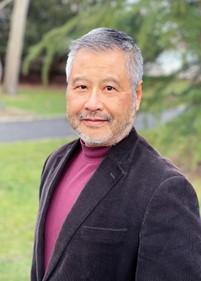
Prof. Benjamin S. Hsiao
(Distinguished Professor of Chemistry, Stony Brook University)
Dr. Benjamin S. Hsiao is a Distinguished Professor in Chemistry at Stony Brook University, USA. He has a notable reputation in polymer science with over 620 scientific publications. His current research interests are focused on the development of sustainable nanomaterials from underutilized biomass for water purification and food security. Hsiao was elected as Fellow of American Association for the Advancement of Science (AAAS), American Chemical Society, American Physical Society, Materials Research Society, and National Academy of Inventors, and received AAAS-Lemelson Foundation Invention Ambassador, and The Prince Sultan bin Abdulaziz International Prize for Water – The Creativity Prize.

Dr. Lichao Jiao
(Associate Professor at Research Institute of Wood Industry, Chinese Academy of Forestry, Beijing, China)
Dr. Lichao Jiao is an associate professor from Research Institute of Wood Industry, Chinese Academy of Forestry, Beijing China. His research interests include Wood Anatomy and Wood Identification. He has been assigned to the Deputy Coordinator of Working Group 5.16.03 – Multidisciplinary identification of wood of IUFRO (International Union of Forest Research Organizations) (since 2020), Secretariat Member of IAWA (International Association of Wood Anatomists) (since 2020), and Member/Deputy Secretary of Wild Plant Standardization Technical Committee, National Forestry and Grassland Administration (NFGA) of China (since 2023).
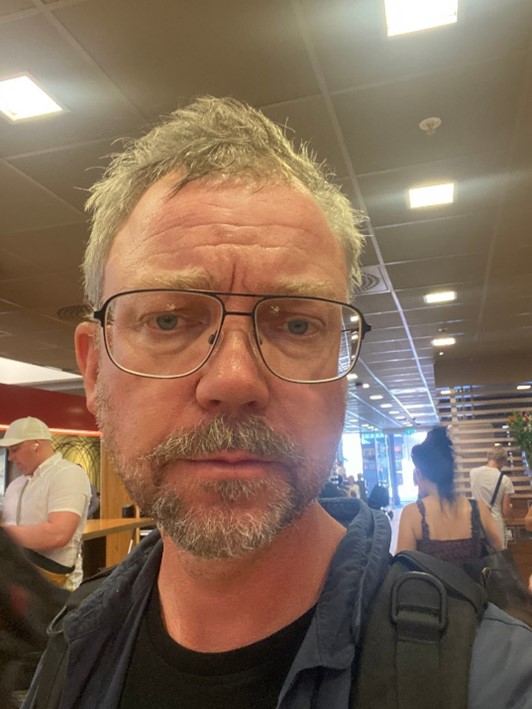
Assoc. Prof. Richard T. Olsson
(KTH Royal Institute of Technology)
Assoc. Prof. Richard T. Olsson earned his PhD in 2007 at the KTH Royal Institute of Technology (KTH) on the topic of microwave absorbing nanocomposites developed for the Swedish Research Defence Agency. Previously, he had developed an interest in polymeric materials when working with optical fibre coatings at École Nationale Supérieure de Chimie de Montpellier in France (-2000) and at Bell Labs, USA (2000–2001). His postdoctoral studies were carried out in 2008-2010 at Consejo Superior de Investigaciones Científicas (IATA), Spain, with focus on renewable nanomaterials within bioplastics for food packaging. He has 8 worldwide patents in the above related fields. Natural polymers are explored, and cellulose nanofibers have been the main topic of investigation over the last 10 years as a member of the Wallenberg Wood Science Centre (WWSC). Further, he serves (since 2015) as an Editorial Board Member for the open access multidisciplinary research journal Scientific Reports (Nature Publishing Group), with an established 5-year impact factor of 4.58. His other research interests are polymer nanocomposite fabrication (thermoplastics, thermoset and biobased) with rapid turnover polymer fomulation investigations, surface adaption of nanoparticles to polymer interfaces, in-situ formation of nanoparticles, extrusion, and electrospinning for anisotropic/isotropic composite fabrication.
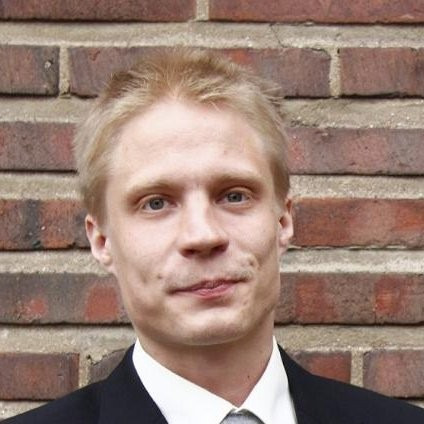
Assist. Prof. Timo Leskinen
(Helsinki University, Finland)
Dr. Timo Leskinen has recently started as an Assistant Professor at University of Helsinki focusing his research on Chemistry of Circular Economy. Dr. Leskinen earned his master’s degree in 2011 from the same Chemistry department of University of Helsinki. He worked for his dissertation in North Carolina State University between 2011 and 2015, focusing on wood-based cellulosic biorefining concepts. In 2015 he returned to Finland and worked as a post-doc research at Aalto University in pioneering work around colloidal lignin until moved to Finnish energy company St1 in 2017. During the nearly 6 years at St1 Dr. Leskinen contributed to development of the first in the world softwood sawdust based cellulosic bioethanol demonstration plant, including development of the pretreatment process and commercialization of the lignin product. In his current position at University of Helsinki, his goal is to establish research focusing on circular economy concepts that can deliver low carbon and sustainable materials to the society.
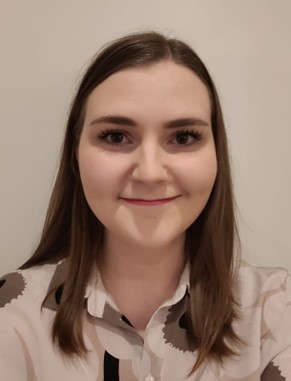
Dr. Katariina Solin
(VTT Research Center, Finland)
D.Sc. (Tech.) Katariina Solin works as Research Scientist at VTT Technical Research Centre of Finland. She received her PhD in Bioproduct technology at Aalto University School of Chemical Engineering. She has expertise in surface analytics and her research is focused on the functionalization of lignocellulose to develop innovative, biobased solutions and materials with advanced functions, including antibacterial coatings, fluidic channels, and sensing systems.
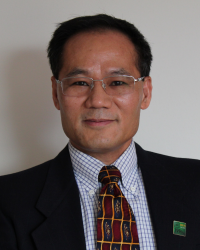
Dr. J.Y. Zhu
Dr. Junyong Zhu is a senior researcher at the Forest Products Laboratory of the United States Department of Agriculture (USDA) in Madison, Wisconsin. His primary research interests are fiber technology and biomass refining. He has worked as a senior researcher at FPL-USDA since 2003. In 2019, he received the US Forest Service Chief’s Award and the IUFRO Scientific Achievement Award. In 2016, he received the Fulbright-Aalto University Distinguished Chair Scholarship. Some of his publications have a global impact, as evidenced by the number of times they have been cited in international publications. His scholarly works have been published in numerous journals and publications by reputable publishers. He engages in professional activities as an editor and member of the advisory board for numerous prestigious international journals, including ACS Sustainable Chem. Eng., Cellulose, BioResources, Bioenergy Research, TAPPI Journal, and China Pulp and Paper. In addition, he is a member of international professional organizations, including the American Chemical Society (ACS) and the American Association for the Advancement of Science (AAAS).
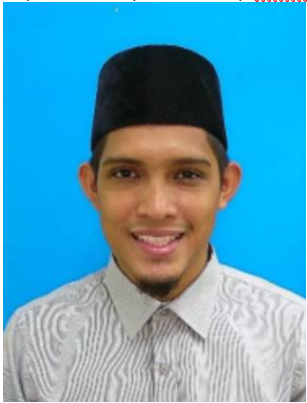
R.A. Ilyas, PhD, FIAAM, FISDS, MRSC, AMIChemE, MIEM
R.A. Ilyas is a senior lecturer in Faculty of Chemical and Energy Engineering, Universiti Teknologi Malaysia, Malaysia. He is also a Fellow of International Association of Advanced Materials (IAAM), Sweden, Fellow of International Society for Development and Sustainability (ISDS), Japan, a member of Royal Society of Chemistry, UK and Institute of Chemical Engineers (IChemE), UK. He received his Diploma in Forestry at Universiti Putra Malaysia, Bintulu Campus (UPMKB), Sarawak, Malaysia from Mei 2009 to April 2012. In 2012, he was awarded the Public Service Department (JPA) scholarship to pursue his Bachelor’s Degree (BSc) in Chemical Engineering at Universiti Putra Malaysia (UPM). Upon completing his BSc. programme in 2016, he was again awarded the Graduate Research Fellowship (GRF) by the Universiti Putra Malaysia (UPM) to undertake a PhD degree in the field of Biocomposite Technology & Design at Institute of Tropical Forestry and Forest Products (INTROP) UPM. R.A. Ilyas was the recipient of MVP Doctor of Philosophy Gold Medal Award UPM 2019, for Best PhD Thesis and Top Student Award, INTROP, UPM. He was awarded with Outstanding reviewer by Carbohydrate Polymers, Elsevier United Kingdom, Top Cited Article 2020-2021 Journal Polymer Composite, Wiley, 2022, and Best Paper Award in various International Conferences. R.A. Ilyas also was listed and awarded Among World’s Top 2% Scientist (Subject-Wise) Citation Impact during the Single Calendar Year 2019, 2020, and 2021 by Stanford University, US, PERINTIS Publication Award 2021 and 2022 by Persatuan Saintis Muslim Malaysia, Emerging Scholar Award by Automotive and Autonomous Systems 2021, Belgium, Young Scientists Network – Academy of Sciences Malaysia (YSN-ASM) 2021, UTM Young Research Award 2021, UTM Publication Award 2021, and UTM Highly Cited Researcher Award 2021. In 2021, he won Gold Award and Special Award (Kreso Glavac (The Republic of Crotia) at the Malaysia Techonology Expo (MTE2022), Gold Award dan Special Award at International Borneo Innovation, Exhibition & Competition 2022 (IBIEC2022), and, a Gold Award at New Academia Learning Innovation (NALI2022). His main research interests are: (1) Polymer Engineering (Biodegradable Polymers, Biopolymers, Polymer composites, Polymer-gels) and (2) Material Engineering (Natural fibre reinforced polymer composites, Biocomposites, Cellulose materials, Nanocomposites).
To date he has authored or co-authored more than 422 publications (published/accepted): 179 Journals Indexed in JCR/ Scopus, 3 non-index Journal, 17 books, 104 book chapters, 78 conference proceedings/seminars, 4 research bulletins, 10 conference papers (abstract published in book of abstract), 17 Guest Editor of Journal special issues and 10 Editor/Co-Editor of Conference/Seminar Proceedings on green materials related subjects.
ICONLIG-IWoRS 2023
Organizing Committee
Advisory Committee
Dr. Akbar Hanif Dawam A., MT.
Tomy Listyanto, S.Hut., M.Env.Ec. Ph.D.
Dr. Ahmad Ilyas bin Rushdan
Prof. Madya Ts. Dr. Mohamad Zaki bin Hassan
Chairman
Dr. Melbi Mahardika, S.T.
Secretariat
Dyah Ayu Agustiningrum, S.TP., M.Si (Coordinator)
Dr. Dian Juliadmi
Dr. Yeyen Nurhamiyah
Riska Suryaningrum, S.Si, M.Sc
Mutia Herni Ningrum, S.Hut, M.Sc
Treasury
Dr. Holilah, S.Si., M.Si
Dr. Firda Aulya Syamani S.TP., M.Si.
Sponsorship
Nanang Masruchin, ST, MT, Ph.D
Program
Dr. Nuzul Ficky Nuswantoro, S.Si (Coordinator)
Karnita Yuniarti, S.Hut., M.Wood.Sc, Ph.D
Dr. Ismail Budiman, M.Si.
Dr. Fitriani
Dimas Triwibowo, S. T., M.T.
Danang Sudarwoko Adi, S.Hut, M. Sc.
Rossy Choerun Nissa, M.Biotek
Erlina Nurul Aini, S.Hut, M.Sc
Bernadeta Ayu Widyaningrum, M.Si
Aulia Nur Laksmita, S.Hut, M.Sc
Consumption and Logistics
Sudarmanto, S.T, M.T. (Coordinator)
Teguh Darmawan, M.Si.
Lisna Efiyanti S.Si., M.Sc.
Rohmah Pari S.HUT
Triastuti, S.T.
Raden Permana Budi Laksana, A.Md
Narto, A.Md
Protocol and MC
Resti Marlina M.Si.
Excursion
Dr. Firda Aulya Syamani S.TP., M.Si. (Coordinator)
Ina Winarni S.Hut, M.Si, Ph.D.
Deni Purnomo, ST., M.Si
Editorial Board of
ICONLIG-IWoRS Conference 2023
Editor in Chief
Dr. Robertus Wahyu N. Nugroho
Section Editor
Prof. Dr. Ir. Wahyu Dwianto, M.Agr.
Dr. Muhammad Adly R.Lubis, S.Hut.
Dr. Ratih Damayanti, S.Hut., M.Si
Dr. Novitri Hastuti, S.Hut, M.Sc
Dr. Imran Arra'd Sofianto
Dr. Novia Amalia Sholeha
Dr. Khatarina Meldawati Pasaribu
Hana Nur Fitriana, Ph.D
Dr. Sarah Augustina, S.Hut., M.Si
Dian Anggraini Indrawan S.Hut., M.M.
Deazy Rachmi Trisatya S.Hut., M.Env.Sc
Putri Amanda M.Si.
Dr. Sena Maulana
Conference Track
- The 2nd ICONLIG, 2022
(The 2nd ICONLIG proceedings will be published in AlP Conference Proceedings, volume 2973) - The 1st ICONLIG-lSSH, 2021
(Proceedings of the 1st of International Conference of Lignocellulose, Springer Singapore)
Guideline for
Paper Submission
AUTHORS GUIDELINE
-
- Please refers to the template on this folder document, named “Template”.
- Paper structure
Papers should be prepared in the following order:- Conference tittle
- Tittle
- Authors’ name and their affiliations
- Abstract and keywords
- Introduction
- Materials and methods
- Results and discussion
- Conclusion
- Acknowledgments (when appropriate)
- References
Please use US English throughout. - Word Limits
The paper should not be less than 5,000 words; excluding the references list.
- Conference Title
This text should be pre-filled. - Title
Click on the existing text and enter the title of the paper using sentence case. - Each author’s name and affiliation, including present address
Authors’ names: Remember to include the correct superscript linking to the appropriate affiliation details.
Affiliations: Remember to include the correct superscript linking to the appropriate author details.
Corresponding author: Remember to include email address of corresponding author. - Abstract (50-100 words)
Insert an abstract of 50-100 words, giving a brief account of the most relevant aspects of the paper. - Keywords
Insert 5 keywords.
Please follow the template style for all the above features.
All tables should be numbered with Arabic numerals. Headings should be placed above tables, and left justified. Leave one line space between the heading and the table. Only horizontal lines should be used within a table, to distinguish the column headings from the body of the table, and immediately above and below the table. Tables must be embedded into the text and not supplied separately.
All figures should be numbered with Arabic numerals (1, 2). All photographs, schemas, graphs, and diagrams are to be referred to as figures. Line drawings should be good-quality scans or true electronic output. Low-quality scans are not acceptable. Figures must be embedded into the text and not supplied separately. Lettering and symbols should be clearly defined either in the caption or in a legend provided as part of the figure. Figures should be placed at the top or bottom of a page wherever possible, as close as possible to the first reference to them in the paper. The figure number and caption should be typed below the illustration in 9pt and left justified. For further guidelines and information to help you submit high-quality artwork please visit https://www.elsevier.com/artworkinstructions. The artwork has no text along the side of it in the main body of the text. However, if two images fit next to each other, these may be placed next to each other to save space. Images should be both included in the template and uploaded as separate high-resolution files.
Equations and formulae should be typed in MathType and numbered consecutively with Arabic numerals in parentheses on the right-hand side of the page (if referred to explicitly in the text). They should also be separated from the surrounding text by one space.
In the text, the number of reference should be given in square brackets. For references with more than two authors, text citations should be shortened to the first name followed by et al., e.g. Jones [1] discovered that…; Recent results from Brown and Carter [2] and Green et al. [3] indicate that…
Only essential references, which are directly referred to in the text, should be included in the reference list.
References must be listed in numerical order at the end of the paper. Do not begin them on a new page unless this is necessary. They should be prepared according to the sequential numeric system making sure that all material mentioned is generally available to the reader.
Journal references should include the author’s surname and initials; initials and surnames of remaining authors; article title (where provided); abbreviated journal title (in italics), year of publication, volume number, and page numbers.
References to books should include the author’s surname and initials; surnames and initials of remaining authors; the book title (in italics); the place of publication and the name of the publisher; and the year of publication. References to multi-author works should include the author’s surname(s) and initials, the chapter title (where provided); “In:” followed by the book title (in italics); initials and name(s) of editors(s) in brackets; volume number and pages; the place of publication and name of the publisher, followed by the year of publication.
Here is an example of some references listed according to the sequential numeric system:
- Van der Geer J, Hanraads JAJ, Lupton RA. The art of writing a scientific article. J Sci Commun 2000;163:51-9.
- Strunk Jr W, White EB. The elements of style. 3rd ed. New York: Macmillan; 1979.
- Mettam GR, Adams LB. How to prepare an electronic version of your article. In: Jones BS, Smith RZ, editors. Introduction to the electronic age, New York: E-Publishing Inc; 1999, p. 281-304.
Avoid hyphenation at the end of a line. Symbols denoting vectors and matrices should be indicated in bold type. Scalar variable names should normally be expressed using italics. Weights and measures should be expressed in SI units. All non-standard abbreviations or symbols must be defined when first mentioned, or a glossary provided.
Corresponding authors, on behalf of all the authors of a submission, must disclose any financial and personal relationships with other people or organizations that could inappropriately influence (bias) their work. Examples of potential conflicts of interest include employment, consultancies, stock ownership, honoraria, paid expert testimony, patent applications/registrations, and grants or other funding. All authors, including those without competing interests to declare, should provide the relevant information to the corresponding author (which, where relevant, may specify they have nothing to declare). Corresponding authors should then use this tool to create a shared statement and upload to the submission system at the Attach Files step. Please do not convert the .docx template to another file type. Author signatures are not required.
Download Guideline for Paper Submission
Event List
| Event | Date |
|---|---|
| Registration | 20 September 2023 |
| Conference | 21-22 September 2023 |
| Conference Dinner | 21 September 2023 |
| Excursion | 23-24 September 2023 |
Rundown
SEMINAR NASIONAL MAPEKI 2023
Rabu, 20 September 2023
Tema: Desain Material dan Inovasi Hijau untuk Pengelolaan Hutan Lestari
| Waktu | Kegiatan |
|---|---|
| Pembukaan | |
| 07.30 - 08.15 | Registrasi |
| 08.15 - 08.30 | Pembukaan oleh MC |
| 08.30 - 08.35 | Sambutan oleh Ketua Acara |
| 08.35 - 08.45 | Sambutan oleh Kepala Pusat Riset Biomassa dan Bioproduk |
| 08.45 - 08.55 | Sambutan oleh Ketua Umum MAPEKI |
| 08.55 - 09.00 | Peralihan dari MC ke Moderator |
| Paparan dari Narasumber | |
| 09.00 - 09.20 | Dr. Krisdianto (KLHK) (Kehutanan Umum) |
| 09.20 - 09.40 | Dr. Akbar Hanif Dawam A., M.T. (PRBB – BRIN) (Tinjauan tentang produk-produk Biomassa) |
| 09.40 - 09.55 | Sesi tanya-jawab untuk dua narasumber |
| 09.55 - 10.00 | Penyerahan Cenderamata dan Foto Bersama |
| 10.00 - 10.15 | Coffee Break |
| 10.15 - 10.35 | Dr. Rita Kartikasari (IPB) (Kimia Kayu / Hasil Hutan Bukan Kayu) |
| 10.35 - 10.55 | Dr. Ratih Damayanti (PRBB – BRIN) (Forensik Kayu / Struktur dan Sifat Kayu) |
| 10.55 - 11.10 | Sesi tanya-jawab untuk dua narasumber |
| 11.10 - 11.15 | Penyerahan Cendramata dan Foto Bersama |
| 11.15 - 11.45 | Penghargaan kepada anggota MAPEKI yang Purna Tugas |
| 11.45 - 13.00 | ISHOMA |
| Parallel Session | |
| 13.00 - 14.00 | Parallel Session 1 |
| 14.00 - 15.00 | Parallel Session 2 |
| 15.00 - 16.00 | Break (Shalat, dan Persiapan Rapat MAPEKI) |
| 16.00 - 18.00 | Rapat Tahunan MAPEKI |
Registration Info
Registeration fee:
| Conference Registration Fee | Early Bird* | Normal* |
| Local | IDR 1.250.000 | IDR 1.500.000 |
| International | USD $125 | USD $150 |
* IDR 300.000 discount for MAPEKI member
Method of payment
Transfer to :
Masyarakat Peneliti Kayu
Mandiri BANK
BIC / SWIFT : BMRIIDJA XXX (international transfer)
Account : 1330011953106
For the conference fee transfer, please use the following format:
name_affiliation_country_iconlig_iwors2023
How to register
Registration through this website is for the purpose of information only. All editorial process, e.g. paper submission, review, are conducted through attached link (ICONLIG 2023). If you have not submitted your full paper though link, we would like to recommend you to do so as soon as possible.
Please be advised that we follow Conference Proceedings policy for non-presented paper, Conference Proceedings reserves the right to exclude a paper from distribution after the conference, including Conference Proceedings Digital Library, if the paper is not presented by the author at the conference.
All registration should be done online through the web. The status of registration is accessible at the participant list page. Username is the same as your registration number.
Password reminder will be sent to the email used in the registration.
Publications
(Scopus Indexed)
- Journal of Applied Polymer Science (Scopus Indexed Q2 (SJR 0.55); JCR WoS Q2; IF 3,057)
- Journal of Sylva Lestari (the Department of Forestry, Faculty of Agriculture, University of Lampung)(Scopus Indexed: Q4; SJR 0,2)
- Indonesian Journal of Forestry Research (Asosiasi Peneliti dan Teknisi Kehutanan dan Lingkungan Hidup Indonesia)(Scopus Indexed Q3 (SJR 0,2))
- BIO Web of Conferences (Scopus and WoS Indexed)
- IOP Conference Series : Earth and Environmental Science (EES)* (Scopus and WoS Indexed)
*) to be confirmed
Organizer
- National Research and Innovation Agency Republic of Indonesia
- Indonesian Wood Research Society
- Andalas University
- Padjajaran University
Contact
Please visit or website:
conference.brin.go.id/iconlig-iwors2023/
Chair of Iconlig-IWoRS 2023:
Dr. Melbi Mahardika
+62 815-3509-327
or kindly send us on email: iconlig@brin.go.id
